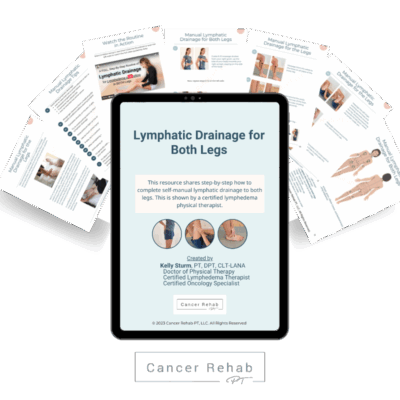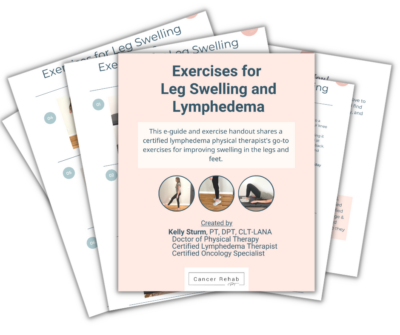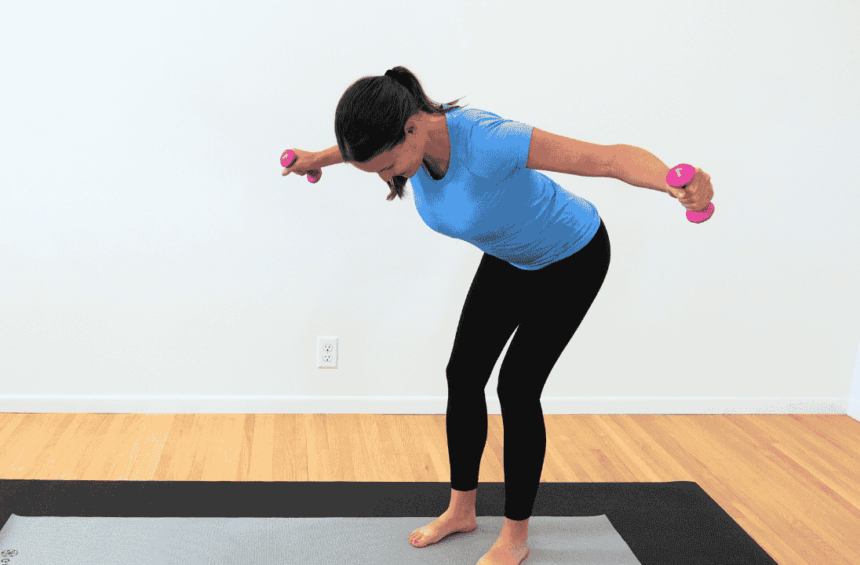When you notice swelling in your arms or legs, it can be difficult to figure out whether it’s caused by lipedema vs lymphedema. These two conditions are often confused with each other, especially in the earlier stages.
Lymphedema and lipedema can look similar at first glance since they both cause swelling, but they’re two completely different conditions.
Lymphedema is a lymphatic system disorder that develops when your body doesn’t have a good flow of lymph fluid. It can often be successfully managed with compression therapy, manual lymphatic drainage, and other methods.
Lipedema, however, has nothing to do with the lymphatic system. It’s a condition where your fat cells abnormally accumulate and create symmetrical swelling in the legs and sometimes the arms. It almost exclusively affects women.
Here’s everything you need to know about lipedema vs lymphedema and how both of these conditions can be improved. For more support, you can also check out Lower Body Lymphedema Rehab.
What Is Lymphedema?
Lymphedema is a chronic swelling in your legs, arms, and other body parts that develops when your lymphatic system gets blocked.
Your lymphatic system is a network of tiny tubes that carry a clear fluid (called lymph) throughout your body. This fluid contains cells that fight infection and other important substances that keep your tissues healthy.
When your lymphatic system gets damaged or blocked, the lymph fluid can’t flow properly and builds up in your tissues. This causes swelling.
The swollen area often feels heavy, tight, or uncomfortable. Over time, the skin can become thicker and harder. Lymphedema usually affects just one arm or leg, though sometimes it can affect both.
Unlike normal swelling that goes away on its own, lymphedema sticks around and often gets worse if not treated. It’s uncomfortable, and it can make your daily life harder as well as increase your risk of getting skin infections like cellulitis.
What Causes Lymphedema?
You can develop lymphedema if there are tubes or nodes in your lymphatic system that are damaged or don’t work right. There are two main types of lymphedema:
- Primary Lymphedema happens when you’re born with lymphatic system problems. It’s rare and can show up at birth, during teenage years, or even as an adult. It often runs in families. Only 1 in 100,0001 people have primary lymphedema.
- Secondary Lymphedema is much more common and happens because of damage to a normal lymphatic system. It often develops after cancer treatment, such as a mastectomy or radiation therapy.
Lymphedema affects up to 10 million Americans2 and hundreds of millions of people worldwide. More people suffer from lymphedema than from multiple sclerosis, Parkinson’s disease, AIDS, and other widespread conditions combined.
Secondary lymphedema often develops as a result of:
- Cancer treatment: Surgery that removes lymph nodes (especially for breast cancer treatment or reproductive cancers) and radiation therapy can damage the lymphatic system and trigger lymphedema.
- Infections: Bad infections can harm your lymphatic system, and in some tropical countries, a common cause of lymphedema is infection with worms that clog the lymph nodes.
- Injuries: Serious wounds, burns, or scars can block your lymph flow and cause lymphedema to develop.
- Being overweight: Extra weight puts pressure on your lymph vessels and makes it harder for fluid to flow.
In severe cases, conditions like chronic venous insufficiency and deep venous thrombosis can also eventually cause lymphedema.
Lymphedema Stages
Lymphedema gets worse in stages, but catching it early helps manage the condition better with physical therapy and other types of lymphedema treatment.
- Stage 0: Your lymphatic system is damaged, but you can’t see any swelling yet. You might feel heaviness or tightness in your arm or leg. At this stage, it’s sometimes possible to reverse the condition or prevent it from developing further.
- Stage 1: Mild swelling appears that might go down when you raise your arm or leg. With good care, the swelling can go down overnight. At this stage, early intervention and effective lymphedema treatment are crucial.
- Stage 2: The swelling gets worse and becomes harder to manage. The tissue starts to get firm, and your skin may thicken. You’ll need specialized treatment and to practice consistent lymphedema self-care at home.
- Stage 3: The swelling becomes severe, with major changes to your skin and tissue. Your skin gets very thick and hard, with folds forming. You’re much more likely to get infections, and everyday activities become harder.
If you notice swelling in your arm or leg, especially after cancer treatment, make sure to get in touch with your medical team as soon as possible to have a physical examination.
Early diagnosis leads to much better results, and sometimes, it’s even possible to reverse lymphedema.
Lymphedema Treatment
Lymphedema is a chronic condition that doesn’t currently have a cure. However, good care can reduce swelling, prevent problems, and improve your daily life.
Complete Decongestive Therapy (CDT) is the gold standard of lymphedema treatment.
It includes:
- Manual Lymphatic Drainage: A special type of gentle lymphatic drainage massage done by a trained therapist or lymphedema professional to help move lymph fluid out of the swollen area.
- Compression Therapy: Using special bandages, sleeves, stockings, or pump devices to keep fluid from building up again after drainage.
- Physical Therapy Exercises: Movement helps your muscles pump lymph fluid and reduce swelling in the affected areas.
- Skin Care: Keeping your skin very clean to prevent infections, which can make lymphedema worse.
After your Complete Decongestive Therapy is complete, you’ll need to maintain the results with at-home lymphedema management strategies.
I share all of them in Breast Cancer Rehab and Lower Body Lymphedema Rehab.
If the swelling doesn’t get better with treatment, you may become a candidate for lymphedema surgery. Surgery can’t cure lymphedema, but procedures like liposuction, lymphovenous bypass, and vascularized lymph node transfer surgery can help with the discomfort.
What Is Lipedema?
Lipedema is a condition where fat builds up in an unusual way, mostly in the legs and sometimes in the arms.
Unlike regular fat, lipedema fat spreads evenly on both sides of the body and usually doesn’t affect your feet or hands. Lipedema fat is most often seen around the hips and thighs, but it can be found in the upper body as well.
People with lipedema often feel pain, tenderness, or heaviness in the affected areas. The skin may feel soft but lumpy or bumpy underneath. You can also bruise more easily in these areas.
Despite its appearance, lipedema is not caused by being overweight – it can affect people of all sizes. Even with strict diets and exercise, the unusual fat deposits don’t go away.
Lipedema affects almost only women. Unfortunately, it’s often mistaken for regular weight gain or lymphedema. This can be very frustrating for lipedema patients because the condition is not only physically uncomfortable but also emotionally distressing.
So, getting a lipedema diagnosis can feel liberating because you’ll finally know where the subcutaneous fatty tissue (a medical way to describe lipedema tissue) is coming from.
What Causes Lipedema?
Doctors don’t fully understand what causes lipedema, but there are a few factors that may play a role:
- Hormones: Lipedema often starts or gets worse during times of hormonal change like puberty, pregnancy, or menopause. This suggests that female hormones like estrogen may trigger or worsen the condition.
- Genetics: Lipedema often runs in families. About 60% to 80% 3of people with lipedema have family members with similar symptoms, so it’s likely that genes play a role.
Unlike lymphedema, cancer treatment is typically not a direct cause of lipedema.
Lipedema Stages
Similar to lymphedema, lipedema progresses through stages as it gets worse.
- Stage 1: The skin surface looks normal, but there are small fat lumps underneath. Your legs may look column-like with an even layer of fat. The skin feels soft and may have some small bumps, but it’s still smooth overall.
- Stage 2: The skin develops more uneven bumps and larger dimples. There are larger fat deposits, and you might develop fat pads just above or around the knees. Your limbs may also feel tender, which is why lipedema is sometimes called “painful fat syndrome.”
- Stage 3: The skin surface becomes very uneven with protruding bulges of fat. You may see large folds and flaps of subcutaneous tissue, especially around the thighs and inner knees. At this stage, it can become difficult to move.
- Stage 4: In this advanced stage, the large amounts of lipedema fat put so much pressure on the lymphatic system that lymphedema develops too (this is called lipo-lymphedema). The typical lipedema patient’s mobility can become very limited.
Lipedema mostly develops on the legs and tends to be symmetrical, affecting both legs equally. This symmetry is one of the key features that helps doctors distinguish it from lymphedema, which typically affects just one limb.
Lipedema Treatment
There’s no cure for lipedema, but several treatment options can help you manage symptoms and improve your quality of life. These options can sometimes include surgical treatment.
- Lipedema exercise: Moving your body regularly helps reduce pain and limb swelling – with lipedema, there may still be some lymph fluid trapped in your legs or arms. Water exercises like swimming can work especially well because they’re easier on your joints.
- 4Healthy eating: Healthy eating won’t eliminate lipedema fat (this is a common frustration for people with lipedema who often eat healthy without seeing any improvement since lipedema fat doesn’t respond to calorie restriction), but certain eating patterns may help reduce inflammation and swelling. For example, a Ketogenic diet may positively impact lipedema.
- Vibration therapy: Standing on specialized vibrating plates may help improve circulation, reduce pain, and decrease fluid buildup. Try these Beginner Vibration Plate Exercises.
- Lipedema surgery: Specialized liposuction techniques can remove lipedema fat while preserving lymphatic vessels. This is different from cosmetic liposuction and should only be performed by surgeons who understand lipedema.
Surgery isn’t considered a cure for lipedema, but it can help reduce pain in the affected limbs, improve mobility, and prevent complications. That said, keep in mind that some fat may eventually return.
Lipedema vs Lymphedema Symptoms
If you’re experiencing swelling in your arms or legs, it can be hard to figure out whether it’s lymphedema vs lipedema. But these conditions have distinct symptoms that can help you and your doctor make the right diagnosis.
Lipedema typically causes symmetrical swelling that affects both sides of your body equally. If you have lipedema in your legs, both legs will be affected in a similar pattern. The swelling will often stop at the ankles, so your feet remain a completely normal size while your legs are enlarged.
When you touch lipedema-affected skin, you might feel small, pea-sized fat lumps underneath. Elevating your arms or legs won’t help reduce swelling, and even losing a lot of weight won’t eliminate the fat tissue.
Lymphedema typically affects just one side of your body, but it’s still possible for both of your legs or arms to be swollen. Unlike lipedema, lymphedema swelling includes the hands or feet – there’s no stopping point at the wrists or ankles. Lymphedema swelling can often improve when you elevate the affected arm or leg.
When you press on lymphedema-swollen skin with your finger, it often creates a dent that remains for a few seconds (called “pitting”). Over time, lymphedema causes your skin to become thicker and harder. It can also sometimes develop a rough texture similar to an orange peel.
Key Lipedema vs Lymphedema Differences
So, how do you know whether you have lymphedema or lipedema? Pay attention to these key differences:
- Pattern: Lipedema affects both sides of your body symmetrically, while lymphedema typically starts in one limb.
- Hands and feet: Lipedema stops at the wrists and ankles, while lymphedema includes hands and feet.
- Pain: Lipedema is often painful, while early lymphedema usually isn’t.
- Gender: Lipedema affects almost exclusively women, while lymphedema affects women and men.
- Touch: Lipedema fat feels soft and lumpy, while lymphedema tissue becomes firm in later stages.
If you notice unusual swelling, pain, or changes in your limbs, don’t wait to get in touch with your doctor. Early diagnosis and proper treatment can make you feel more comfortable and prevent both conditions from getting worse.

Can You Have Both Lymphedema and Lipedema?
Yes, unfortunately, you have both lymphedema and lipedema at the same time. It happens often enough that medical professionals have a specific term for it: lipo-lymphedema.
This condition typically develops when someone has lipedema for many years, and the abnormal fat deposits eventually damage the lymphatic system and cause lymphedema as a secondary condition.
When people have both lymphedema and lipedema, their symptoms naturally become more complex.
They might experience symmetrical fat deposits and pain as a result of lipedema as well as fluid retention and increased risk of infection that are typical for lymphedema.
The swelling can also extend into your hands and feet.
Specialists can create a treatment plan that addresses both conditions, often combining compression therapy, manual lymphatic drainage, physical therapy, and sometimes surgical options.
It’s possible to prevent lymphedema from progressing with proactive treatment and self-care.
You don’t have to accept swelling and pain as your new normal. You can find effective techniques and exercises to manage lymphedema in Lower Body Lymphedema Rehab.
FAQs
How Do You Know If You Have Lipedema or Lymphedema?
You and your doctor need to take a close look at the pattern and characteristics of your swelling. Lipedema typically causes symmetrical swelling in both legs (or sometimes arms) that stops sharply at the ankles or wrists, so your feet and hands stay normal-sized. The affected areas are often painful. Lymphedema usually affects one limb, including the hands or feet, and isn’t typically painful initially.
It’s essential to get a proper diagnosis because the treatment options for lipedema vs lymphedema are different. For example, weight loss won’t help with lipedema, but it can help reduce lymphedema swelling.
Can Lipedema Turn Into Lymphedema?
Lipedema itself doesn’t turn into lymphedema, but it can lead to secondary lymphedema – this condition is called lipo-lymphedema. As lipedema progresses, the abnormal fat deposits can put increasing pressure on your lymphatic system and cause lymph fluid to build up. This typically happens in advanced stages of lipedema or after many years of living with the condition without proper management.
The risk increases if you’ve had surgery that affected your lymphatic vessels, such as during breast cancer treatment.
What’s the Difference Between Lymphoedema and Lipoedema?
Lymphoedema (lymphedema) and lipoedema (lipedema) are different conditions that affect different body systems. Lymphoedema develops as a result of a malfunctioning lymphatic system, which causes lymphatic fluid retention and swelling. It typically only affects one leg or arm, including the hands and feet. Lipoedema is a condition that develops because of abnormal fat cell distribution and growth – it doesn’t have anything to do with the lymphatic system. It typically affects both sides of the body symmetrically and stops at the wrists or ankles.
What Is the Pinch Test for Lipedema?
The pinch test for lipedema is a technique that doctors use to help diagnose lipedema and distinguish it from other conditions like obesity. During this test, the doctor gently pinches the skin on suspected lipedema areas (such as the thighs) and compares the sensation and appearance to non-affected areas like your stomach. In lipedema, the pinched skin is often painful, and pinching regular fat usually causes only minor discomfort. People with lipedema might also notice that the pinched skin has a different texture and feels “grainy” under the surface.
What Is the Life Expectancy of Someone with Lymphedema?
Lymphedema itself doesn’t shorten your life expectancy, and many people with lymphedema lead full, active lives with proper management. It’s a common misconception that you have to accept swelling and discomfort as your new normal when living with lymphedema. Physical therapy, proper skin care, compression therapy, manual lymphatic drainage massage, and other techniques can help you minimize lymphedema symptoms and maximize your quality of life.
You can find physical therapy exercises and self-care techniques in the Lower Body Lymphedema Rehab and Breast Cancer Rehab.
What Is the Life Expectancy of Someone with Lipedema?
People with lipedema can live a normal lifespan, especially with proper management. Without effective treatment, the condition impacts the quality of your life through chronic pain, reduced mobility, and psychological effects. The greatest health risks come from potential complications if lipedema progresses to later stages and especially if it develops into lipo-lymphedema, which can increase your risk of infections. Early diagnosis, proper treatment, and taking care of your overall health with exercise and healthy eating can help you improve your quality of life with lipedema.
Can Losing Weight Reverse Lymphedema?
Losing weight alone typically won’t reverse lymphedema, but it can help minimize swelling and improve your symptoms. Excess weight puts additional pressure on your lymphatic system, which is already not working properly, so reducing this pressure can help a lot with swelling and mobility. You should also combine weight loss with other lymphedema management strategies, such as wearing compression garments, manual lymphatic drainage, exercise, and skincare.
Lymphedema vs Lipedema: Final Thoughts & What to Do
Living with chronic swelling and discomfort is difficult, whether it’s caused by lymphedema or lipedema. Fortunately, there are effective treatment options and management strategies for both lymphedema and lipedema.
The most important step is getting the correct diagnosis from a doctor who understands these conditions. Both conditions need different treatments, so knowing which one you have (or if you have both) makes a big difference.
Don’t settle for being told, “It’s just weight gain” if you have symptoms of lipedema. Similarly, if you have lymphedema, you don’t have to accept swelling as your “new normal” and just learn how to live with it.
There are effective treatment options for both conditions, and they don’t always have to involve surgery.
Early treatment works best, so don’t wait until your symptoms get worse. With proper care, many people can manage their symptoms, reduce discomfort, and stay active.
You can find education, management techniques, and physical therapy exercises in Lower Body Lymphedema Rehab, Breast Cancer Rehab, and my Exercise Guides.
Article Sources
- Sleigh BC, Manna B. Lymphedema. [Updated 2023 Apr 19]. In: StatPearls [Internet]. Treasure Island (FL): StatPearls Publishing; 2025 Jan-. Available from: https://www.ncbi.nlm.nih.gov/books/NBK537239/ ↩︎
- The Lymphatic Education & Research Network ↩︎
- Morgan S, Reid I, Bendon C, et al. A Family-Based Study of Inherited Genetic Risk in Lipedema. Lymphat Res Biol. 2024;22(2):106-111. doi:10.1089/lrb.2023.0065 ↩︎
- Keith, L., Seo, C. A., Rowsemitt, C., Pfeffer, M., Wahi, M., Staggs, M., Dudek, J., Gower, B., & Carmody, M. (2021). Ketogenic diet as a potential intervention for lipedema. Medical hypotheses, 146, 110435. https://doi.org/10.1016/j.mehy.2020.110435 ↩︎











